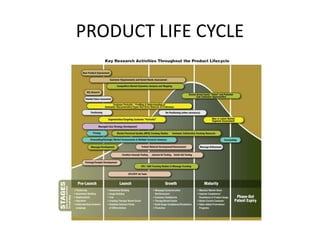
PLC STAGES: PRICE, COST, MARKETING
- 2. Product Life Cycles Sales Development Introduction Growth Maturity Saturation Decline Time
- 3. Introduction Stage of the PLC Sales Low sales Costs High cost per unit Profits Negative Marketing Objectives Create product awareness and trial Price Usually Price Penetration or Skimming for innovative product Advertising Heavy Advertisement
- 4. Growth Stage Of The PLC Sales Rapidly rising sales Average cost per unit (EOS) Costs Profits Rising profits Marketing Objectives Maximize market share Product Offer product extensions, service, warranty Price Penetration if new entrants Advertising Build awareness and interest in the mass market
- 5. Maturity Stage Of The PLC Sales Peak sales Costs Low cost per unit (EOS) High but Generally lower than Growth stage Profits Marketing Objectives Maximize profit while defending market share Product Diversify brand and models Price to match or best competitors Price Stress brand differences and benefits Advertising
- 6. Decline Stage Of The PLC Sales Declining sales Costs Low cost per unit Profits Declining profits Marketing Objectives Reduce expenditure and milk the brand Product Phase out weak items Price Cut price Advertising Reduce to level needed to retain hard-core loyal customers
- 8. Design costs of the product
- 9. Minimize time to market
- 11. Question PQ manufactures and sells consumer electronics. It is constantly working to design the latest gadgets and “must-haves” which are unique in the market place at the time they are launched. The management of PQ are aware of the short product life cycles in this competitive market and consequently use a market skimming pricing strategy at the introduction stage. Required: Explain the changes that are likely to occur in the following items at the three later stages in the product life cycle of a typical PQ product. (i) Selling price (ii) Production costs (iii) Selling and marketing costs (Total for Question Two = 10 marks)
- 12. Answer (i) Selling price changes It is likely that throughout the growth, maturity & decline phases there will be a gradual reduction in the selling price of the product, but the reasons for the reductions are different for each phase. In the growth phase, PQ will be aware that their competitors may have purchased the product during its introduction phase and may have reverse engineered it and perhaps produced a competitive product. Therefore PQ will be keen to try and keep the competition from entering the market by making the item less profitable. Secondly, in order for PQ’s product to be demanded by a greater number of consumers the price will have to be reduced. In the maturity phase, the price will be reduced further to encourage further sales while a replacement product is being finalised and introduced to the market so that PQ continues to receive cash inflows to support its continued product development. In the decline phase, PQ will reduce the price still further as by now its replacement will have been introduced to the market and PQ is therefore attempting to clear its inventory of any remaining units of the old product. (ii) Production cost changes During the growth phase it is likely that there will be reductions in the unit production costs due to economies of scale and the application of the learning and experience curve to the greater volumes until a post learning position is achieved. In the maturity phase there is unlikely to be significant further reductions in unit production costs. In the decline phase, PQ will wish to minimise its expenditure so that it can derive as much profit as possible from the final sales of the product, but its production costs may increase due to possible machine breakdowns and inefficiencies. (iii) Selling and marketing cost changes During the growth phase it is likely that there will be significant selling and marketing cost as the product is sold to a more general audience compared to the introduction phase when sales were made to a smaller targeted group of consumers. In the maturity phase, selling and marketing costs can be reduced as the product is established and is selling itself by word of mouth and reputation. In the decline phase, selling and marketing costs will be cut since production will cease during this period.